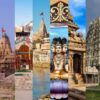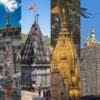Kerala is a state located on the southwestern coast of India. Known for its stunning natural beauty, it has a unique mix of landscapes, including lush backwaters, hill stations, pristine beaches, and rich cultural heritage.
Some recommended places you can visit in Kerala:
1. Alleppey (Alappuzha) – “Venice of the East”
Name Significance:
The name Alappuzha is derived from “Ala” (canal) and “Puzha” (river), meaning “the river with many canals.”
It is often referred to as the “Venice of the East” due to its picturesque backwaters and network of canals.
What It’s Known For:
Backwaters: Alleppey is famous for its backwater cruises, where tourists can enjoy houseboat rides through tranquil waters surrounded by lush green landscapes.
Nehrutrophy Boat Race: An annual event during Onam, featuring traditional Kerala snake boats competing in a race.
Kuttanadu: Known for its unique agricultural practices in the wetlands, Kuttanadu is referred to as the “Rice Bowl of Kerala.”
2. Munnar – “Land of the High Range”
Name Significance:
The name Munnar is believed to derive from the Malayalam words “Munu” (three) and “Aru” (river), referring to the convergence of three rivers—Mudrapuzha, Nallathanni, and Kundala—in the region.
What It’s Known For:
Tea Plantations: Munnar is often called the “Tea Garden of Kerala” due to its vast tea plantations, which stretch across the hills and contribute to Kerala’s tea production.
Eravikulam National Park: Home to the endangered Nilgiri Tahr, a species of mountain goat.
Anamudi Peak: The highest peak in South India, offering treks and stunning panoramic views.
3. Kumarakom – “Vembanadu Lake”
Name Significance:
Kumarakom is named after the local village Kumara (Lord Kartikeya) and the word Komaram (wooded area). The area is mainly known for its proximity to Vembanadu Lake.
What It’s Known For:
Vembanadu Lake: This is Kerala’s largest backwater lake. Tourists can take boat rides in traditional houseboats.
Kumarakom Bird Sanctuary: A haven for migratory birds, especially during the winter months, making it a hotspot for birdwatching.
Spice Plantations: The region is known for its lush plantations of coconut, banana, and rubber trees.
4. Kochi (Cochin) – “Queen of the Arabian Sea”
Name Significance:
Kochi is derived from the Malayalam word Kochu (small) and Azhi (lake), referring to its small lake.
Historically called Cochin, it earned the title “Queen of the Arabian Sea” due to its importance as a port for trade in the 14th century.
What It’s Known For:
Fort Kochi: A historical area that reflects the rich colonial heritage of Kerala, with influence from Portuguese, Dutch, and British colonization.
Chinese Fishing Nets: These large, shore-operated fishing nets are an iconic sight in Fort Kochi.
Mattancherry Palace: Built by the Portuguese, the palace houses beautiful murals depicting Kerala’s history.
Jew Town: A historical district with the Paradesi Synagogue, one of the oldest active synagogues in the Commonwealth.
Kochi Marina: A modern marina located along the coast, ideal for a stroll.
5. Thekkady – “Spice Capital of Kerala”
Name Significance:
Thekkady is derived from the local word “Thekkar,” meaning the southern region or the southern part of a place. It is often referred to as the spice capital of Kerala due to its abundant spice plantations.
What It’s Known For:
Periyar Wildlife Sanctuary: A sanctuary located around Periyar Lake, home to various wildlife, including elephants, tigers, and leopards.
Spice Plantations: Thekkady is famous for its spice plantations, where you can explore and learn about the cultivation of cardamom, pepper, and cloves.
Boat Rides: Boat rides on Periyar Lake offer the chance to spot wildlife in their natural habitat.
6. Varkala – “Papanasam Beach”
Name Significance:
Varkala is believed to have gotten its name from Vara (an ancient Sanskrit term for an offering to a deity) and Kala (time or place), a reference to the ancient spiritual significance of the place.
Papanasam means “washing away sins,” and the beach is believed to have purifying properties.
What It’s Known For:
Varkala Beach: Known for its cliffs that rise majestically from the shore, it is a popular spot for relaxation and water sports.
Papanasam Beach: This beach is sacred and is believed to wash away sins for those who dip in its waters.
Sivagiri Mutt: The final resting place of the social reformer Sree Narayana Guru, this is an important pilgrimage site.
Janardanaswamy Temple: A 2,000-year-old temple dedicated to Lord Vishnu, located near the beach.
7. Kovalam – “Lighthouse Beach”
Name Significance:
Kovalam translates to “a grove of coconut trees,” reflecting the abundance of coconut trees in the region.
Lighthouse Beach is named after the prominent lighthouse situated on a rocky promontory overlooking the Arabian Sea.
What It’s Known For:
Lighthouse Beach: Known for its towering lighthouse and scenic views of the sea, it’s a popular spot for tourists.
Hawa Beach and Samudra Beach: These quieter beaches are ideal for swimming and sunbathing.
Water Sports: Kovalam is famous for surfing, kayaking, and parasailing, offering thrilling water activities for adventure seekers.
8. Athirappilly – “Niagara of India”
Name Significance:
Athirappilly is named after the Athirappilly River, which cascades from the Western Ghats to form the majestic waterfall. Its beauty has earned it the nickname “Niagara of India”.
What It’s Known For:
Athirappilly Waterfalls: This stunning waterfall, surrounded by lush greenery, is one of the largest in Kerala. It is often compared to Niagara Falls due to its vast size and powerful flow.
Vazhachal Waterfalls: Another beautiful waterfall located close to Athirappilly, offering a peaceful natural environment.
River Cruises: Enjoy a boat ride along the Chalakudy River to explore the surrounding forest area.
9. Wayanad – “Land of Paddy Fields”
Name Significance:
Wayanad is believed to be derived from Wayanadu, meaning “land of paddy fields,” due to its extensive agricultural fields, particularly rice cultivation.
What It’s Known For:
Edakkal Caves: Known for ancient petroglyphs that date back over 6,000 years, making them one of the earliest forms of writing in India.
Wayanad Wildlife Sanctuary: Home to elephants, tigers, and other wildlife, this sanctuary is a biodiversity hotspot in the Western Ghats.
Soochipara Waterfalls: Known for its stunning three-tiered waterfall, ideal for nature lovers and trekkers.
Pookode Lake: A scenic freshwater lake that offers boating opportunities amidst the natural beauty of the surrounding forests.
10. Padmanabhaswamy Temple, Thiruvananthapuram – “The Richest Temple in the World”
Name Significance:
The Padmanabhaswamy Temple is dedicated to Lord Vishnu in his reclining form. The temple’s name is derived from Padmanabha, meaning “one who holds the lotus,” as Vishnu is depicted with a lotus in his hand.
What It’s Known For:
Padmanabhaswamy Temple: It is famous not only for its stunning Dravidian architecture but also for its immense wealth, making it one of the richest temples in the world.
Napier Museum and Sree Chitra Art Gallery: These two museums are close to the temple and house collections of Kerala’s art and culture.
Kuthira Malika Palace: Built by the Travancore kings, this palace is a fine example of Kerala’s traditional architectural style.
These places in Kerala each have a unique history and significance that contribute to the state’s charm and appeal. Whether you’re looking for history, culture, nature, or spirituality, Kerala offers a destination for every type of traveler.




